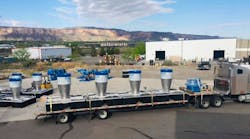I doubt anyone would argue that the past six months have brought great change for our country, and much of the world. Some parts of our economy were (and remain) virtually shut down. For those fortunate enough to continue to be open and viable, great changes and the need to solve new, large and diverse problems is the new daily reality.
I have always admired creative people. People who, when faced with a challenge, approach it with curiosity and openness. When others freeze or panic, these special people keep their calm and boldly innovate through it.
I’m not referring to geniuses that bring us big technological breakthroughs like Elon Musk or Steve Jobs or scientific geniuses like Albert Einstein, Linus Pauling or Madame Curie. I mean the unsung heroes, the everyday creative wizards solving real business-threatening problems that pop up fast and furious during times of great change.
We’ve all heard about, and maybe some of us have even experienced, COVID-related supply chain problems. When the pandemic set upon us, suppliers and factories closed abruptly, leaving many with big gaps of availability of materials (raw or processed) needed to produce the products they make.
I’ll give you an example—an inspiring tale of a real, creative workaday person that took great change head on and overcame it. The story of Bob Ballantyne, a director of research and development, and his team at Resource West in Grand Junction, Colorado.
A couple of weeks ago, I had a chance to talk to Bob about the results they were seeing at Resource West. To call it impressive during the current climate is an understatement. Resource West is up about 20%, year-over-year. According to Bob, if he and his team had not taken the actions I’m about to explain, they would be down, big league. But going from negative territory to +20% is a big delta. That’s a job-saving-and-creating positive delta.
Resource West makes evaporators. Evaporators reduce waste water, which reduces costs and is environmentally beneficial. It occurred to them their technology could also be used to sanitize large public spaces: arenas, gas stations, and convention and conference centers. They found opportunity, dug in, did their research and developed a sanitizing line of equipment.
But they didn’t stop there.
They faced real shortages in purchased parts, due to supply chain interruptions. So, they hired young engineers from college and redesigned the parts that could be made from composites. They bought six large 3D printers and began to make the parts themselves, bringing a big aspect of the supply chain in-house while simultaneously cutting down on unit costs.
Injected plastic parts were also becoming a problem with a backup in mold design and production. In response, the team researched electrical discharge machining (EDM) and began designing their own molds to overcome issues in the supply chain. “The EDM is our next phase,” said Ballantyne. “We tested the theory by pricing the production process out and seeing what the return on investment was—and we’ve decided it is a go. We are now in the research phase of making the correct unit decision.”
Ballantyne looks at recessions not as a scary thing, but as time to look at what could be changed and improved—and then do it. He says during flush economic times, you don’t always have the time to innovate. You’re too busy trying to keep up with demand. A recession (for some) provides the time and motivation to innovate and make improvements when you otherwise would not. In other words: innovate.
During recessions, you have the greatest opportunity to put more distance between you and your competitors, if you use that time wisely.
There’s a silver lining in everything—even in manufacturing.
Myron Moser is chairman of the board at Hartfiel Automation and strategic advisory board member, Alliantgroup.




